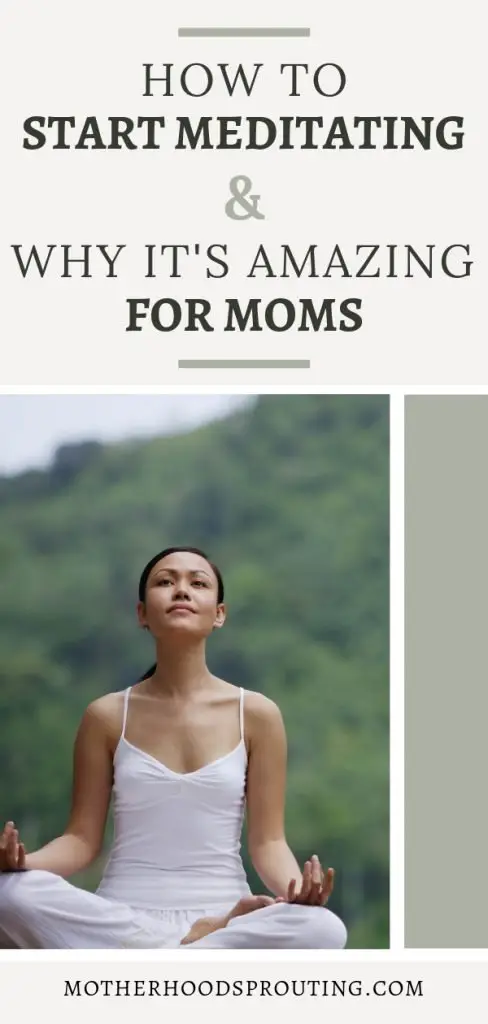In this post, you will learn how to start meditating and why it’s amazing for moms.
By the end of this post, you will understand:
- Why meditation is amazing for moms
- The benefits of meditation
- How to meditate
- How to prepare your meditations
- How to find the time to meditate
- How to accessorize your meditation
Have you been feeling stressed and overwhelmed lately?
Have your kids been pushing your buttons more easily?
Do you feel like the littlest struggles just send you into a raging fit?
Do you feel anxious or depressed?
Well, if you feel any of those things above, you’re in the right place. I have a tool that will help you feel a whole lot better — every single day.
Meditation is a tool
First of all, I want you to know you’re not alone.
Being a mom is really stinking hard. Some days it can feel like your kids are literally sucking the life out of you. Admitting that does not make you a bad mom. We all feel this way at some point or another, if not all the time.
But let me let you in on a little secret…it doesn’t have to be that way. A daily meditation practice can make motherhood so much more enjoyable.
Motherhood will always be throwing shit your way. Literally and figuratively. Meditation cannot stop children from being children. Teething, tantrums, messes, and the like will remain a big part of your life.
However, meditation CAN alter your mindset.
While motherhood won’t ever be easy, it will feel a whole lot easier with a daily meditation practice.
Meditating has the power to change your brain and body and make you less stressed and anxious; therefore, you’re less likely to react negatively to the shit that gets thrown your way.
Why is meditation is amazing for moms?
Since starting a consistent daily meditation practice, I have noticed a HUGE difference in my anxiety and stress levels. But the biggest thing I have noticed is that I am not yelling at my daughter when she pushes my buttons like I used to. When she does something I don’t want her to do I am able to calmly talk to her, not raise my voice, and approach the situation more reasonably.
Before I started meditating, when my daughter wasn’t listening, it would make me so angry and frustrated. I would end up yelling and making it into a big deal, which it didn’t need to be. Then I would feel guilty for yelling, spiral into a negative place, and generally feel like an awful mom.
Now, I’m not perfect. There are still moments when she pushes me to my breaking point, but they are few and far between. Plus, I am now able to recognize those moments and pull myself back more quickly. Which honestly feels like a superpower and I’m loving it!
Basically, meditation is such a powerful tool for mothers and I want you to try it for yourself! If meditation sounds like something you want to try but you have no idea where to start, learn how to start meditating below.
What are the benefits of meditation?
I find that when I fully understand why I’m doing something, I’m more likely to do it. If someone told you to eat 5 carrots every day for lunch but wouldn’t tell you why you probably wouldn’t rush out to buy carrots.
On the other hand, if someone told you eating 5 carrots every day for lunch would make you insanely smart, you’d probably make sure to always have carrots in the house.
Understanding the incredible benefits of meditation is the driving force that turns it into a daily habit.
According to Matthew Thorpe MD, PhD, there are 12 Science-based benefits of mediation:
- Reduces Stress
- Controls Anxiety
- Promotes Emotional Health
- Enhances Self Awareness
- Lengthens Attention Span
- May Reduce Age Related Memory Loss
- Can Generate Kindness
- May Help Fight Additions
- Improves Sleep
- Helps Control pain
- Can Decrease Blood Pressure
- You Can Meditate Anywhere
If you’re feeling doubtful that simply meditating every day can actually produce physiological changes in your body, just Google it and you’ll find new studies coming out every year to prove it.
In a recent study done by Massachusetts General Hospital, Sara Lazar, Ph.D., found that meditating an average of 27 minutes a day over an 8-week period can change the structure of your brain in a positive way.
The study showed, “an
If you’re not yet convicted meditation is worth your time, read this study and be amazed!
How do you meditate?
In order to meditate and reap all the incredible benefits, you obviously need to know how to do it!
Often people shy away from meditation because they think it’s going to be hard, they don’t know how to visualize, they can’t quiet their crazy minds, etc.
Meditation is accessible to everyone and doesn’t have to be hard! You just have to learn the basics of meditation.
Here are 5 things you need to know about meditation in order to start meditating now:
1. The different types of meditation
There are so many different ways that you can meditate. To make it easier on you, I will list the 5 most common types of meditation and a brief description of what they are. Once you decide on one or more meditation types you’d like to try, feel free to do further research to make sure you fully grasp the concept before you begin.
- Guided Meditation: When someone is walking you through every step of your meditation either in person or through a recording. Guided meditations are great for beginners because the facilitator will tell you what to focus on, how to breath, what to visualize, etc. I love guided meditations and find it easier to focus when my mind is not left to its own devices!
- Mindfulness Meditation: When you practice becoming completely connected to the present moment and become keenly aware of all your senses in the now. For example, in mindfulness meditation, you focus on your
breathe
- Kundalini Mediation: A part of Kundalini Yoga, meant to awaken the kundalini energy at the base of your spine. Kundalini emphasizes the breathing and reciting mantras. It’s purpose is to purify and cleanse the energy systems of the body.
- Walking Meditation: A mindfulness meditation you do walking and obviously with your eyes open. In a walking meditation you walk/pace slowly while focusing on your breathe, the sensations of your body, or even a mantra. A walking meditation can be extra wonderful and grounding when done out in nature or barefoot.
- Transcendental Meditation: A meditation that’s done for 20 minutes twice a day that consists of repeating a mantra. Although it is supposedly the easiest and most powerful form of mediation, it is shrouded under a bit of secrecy. In order to correctly practice Transcendental Meditation you have to learn it from a certified practitioner through a 4-day course that you obviously have to pay for. During that course you will get assigned your special mantra. I’ll admit, this type of meditation sounds a bit sketchy at first, but after you look into a bit more it’s quite alluring.
2. How to sit when meditating
There are really no “rules” when it comes to how and where to sit when meditating. Still, here are some general guidelines I like to follow to get the most out of my meditations.
- Get really comfortable: The most important thing is that you are comfortable and able to relax. If you are sitting in a way that brings pain to any part of your body thats probably going to be quite distracting and not allow for a good meditation.
- Sit upright: When I’m meditating I like to sit upright in a chair with my back against the back of the chair for support (I have a weak back and can’t sit unsupported for very long). If you have a stronger back than me, you can sit on a meditation pillow, blanket or yoga mat. Many meditation teachers will give you the option to lay flat on your back during your meditation. Personally, that always makes me fall asleep! You can try it for yourself, but if you fall asleep easily, I recommend not laying down for your meditation.
- Don’t cross your arms or legs: Unless you are sitting in lotus position, it best to not cross you arms or legs. This allows for better relaxation and flow of energy.
- Hand position: You can lay your hands wherever they feel most comfortable. I usually place my hands gently on my lap with my palms facing up. If you are doing a Kundalini meditation, you will most likely have specific hand and finger positions to use.
3. How long and how often you should meditate
After doing my research, I found the general consensus to be that an established meditation practice should be meditating twice a day for at least 20 minutes each time. That being said, any amount of meditation is a good amount.
If you can only squeeze in 10 minutes a day, that’s okay! You will still feel better than if you didn’t meditate at all. I think making a goal to meditate for 10-15 minutes every day is a really good place to start.
4. How to quiet your thoughts when meditating
Like I said at the beginning of this section, a lot of people shy away from trying meditation because they just can’t silence their thoughts. It’s a common misconception that the paint of meditation is to render yourself thoughtless.
However, most reputable meditation teachers will tell you that trying to empty your mind of thoughts is actually impossible and you should never make that the basis of your meditation practice.
Instead, simply allow your thoughts to fly by without engaging with them. Of course, that’s easier said than done, but that’s where point number five come in.
5. Practice makes perfect when meditating
Meditation is an exercise for the mind. It’s not going to be easy and super comfortable the first few times you do it. But the more often you practice the stronger your mind becomes and the easier it gets.
Don’t be scared away if you’re not feeling a magical, blissful euphoria after you first start
Keep on keeping on and I promise, speaking from experience, you will reach a point where you start to crave your daily meditation because it feels that incredible.
If you’re a beginner, all of that might seem overwhelming and complicated, but I promise you it’s not.
Meditation is basically the practice of sitting down, closing your eyes, tuning out the outside world, and intentionally focusing your mind on something; whether it’s your breath, a mantra, music, or the imagery in a guided meditation.
How do you prepare your meditations?
Now you know the basics of how to meditate. Next, you need to prepare your meditations.
One of the quickest ways to stop your meditation practice before you even begin is to not know what kind of meditation you’re going to do every day. Meaning, you wake up at 5 am excited and ready to meditate, but you don’t have a guided meditation to listen to or the right music, etc so you waste 10 minutes looking for one and then your kids wake up and you’re screwed.
Here are 4 different places to find meditations:
1. Meditation apps
Luckily, we live in a great time period where there is an app for everything. Meditation
2. Perchase meditations
Another thing you can do is simply purchase meditations on iTunes, Google Play, etc. You can buy whole albums or single meditations depending on what you’re looking for.
3. Find meditations on Spotify
Another way you can prepare your meditations is to create a playlist on Spotify. What I love about this option is that it is completely free! I created a meditation playlist of over 40 different guided meditations from great meditation teachers like Deepak Chopra and Abraham Hicks. You can make your own playlist by searching “guided meditations”, “meditation music”, etc. Or you can use mine by clicking here!
4. Find free meditation downloads
One of my personal favorite ways to get great meditations is to get free meditation downloads by signing up for someone’s email list. Yes, I have done this many times and I have no shame.
You can get free meditations on Gabby Bernstein, Ziva Meditation, Marisa Peer, and so many more. The added bonus is that you are now on these incredible teachers’ email lists and will continue to receive great content and future freebies via their newsletter.
5. Just meditate in silence
I do want to point out that meditation does not require a technological device and headphones. You can meditate by just listening to the sounds of nature, your own breath, or a mantra you recite to yourself. However, I do think that when you are just starting out it’s helpful to have something you can anchor your thoughts to and focus on, be it a spoken guided meditation or a piece of music. Just know that it’s not required in any way.
How do you make time for meditation?
Okay, I know you’re a busy mother, so let’s address the elephant in the room.
Meditation sounds incredible and you really want to commit to it, but how the hell are you supposed to find the time to meditate for goodness sake when you can barely find time to go pee by yourself?!
I hear you. Trust me, I know the struggle of not having enough time when you’re a mother. But let me just throw you the harsh reality — if you want to truly feel the benefits, you have to make the time for your meditation practice. Period. You have to make it a priority, build it into your schedule, and do whatever you have to do.
3 times of the day you can meditate when you’re a mom
1. Before your children wake up in the morning
Yes, you might have to wake up a little bit earlier. But in the big scheme of things, waking up 15-20 minutes earlier is not going to be that difficult. I find meditating in the morning to be really invigorating. It set’s up the energy for the day really nicely. Lately, I have been doing my morning meditation sitting up in bed which makes it that much easier to do.
2. During nap time
My absolute favorite time to meditate used to be during my daughter’s afternoon nap. It was like a beautiful mid-day pick me up. The only obstacle here would is if you have more than one child and they nap at different times. Or if your children don’t nap anymore, like mine, but aren’t old enough to be left on their own while you zen out.
3. After your children go to sleep
If you have it in you to stay up after your children go to sleep to catch up on your favorite shows then you can hang in there an extra 15-20 minutes to meditate! My suggestion would be to start your meditation immediately after your children are asleep. Do it first and that way you don’t get caught up in other things and end up being too tired to meditate.
Basically, work around your childrens sleep schedule
All of the options above are based on your children’s sleep schedule. I’m assuming you’re in the same boat as me and you only get uninterrupted alone time when your children are sleeping.
However, if you have a babysitter, nanny, or husband who wants to watch the kiddos while you get your meditation on, then please take that opportunity. I still highly recommend scheduling it in and not just waiting for an opportunity for alone time to present itself.
Do you need accessories to meditate?
The final step in starting a mediation practice is to “accessorize” your meditation. If you’re a bit confused, let me explain — just like accessories can make any outfit better but are not required to leave the house, meditation accessories are not required but can definitely enhance the experience.
Before I do my meditations I like to light a candle and roll on some essential oils. I don’t do it every time I meditate, but it definitely helps me relax and get in the zone faster when I do.
Here are 4 meditation accessories you can use to enhance your meditation experience
1. Candals
There is something about lighting a candle that is instantly relaxing. I like to use soy/non-toxic candles so I’m not adding any unnecessary chemicals to the air for me or my daughter to breathe.
2. Essential Oils
Essential oils can be a great way to help your body relax before your meditation. For example, lavender is known to have a soothing and calming effect on the nervous system. You can either use essential oils directly on your skin or you can diffuse them. Just make sure you do your research so as to not use any oil that isn’t safe for children or needs to be diluted before using on your skin.
3. Crystals
Adding crystals to your meditation can raise your consciousness and awareness, protect your energy, or amplify your intentions. You can click here to learn more about meditating with crystals. If it’s too “woo woo” for you, then feel free to just move ahead.
4. Meditation pillow
If you plan on doing your meditations on the ground, which many meditation teachers do recommend, you may want to get yourself a meditation pillow. Meditation pillows just support you and keep you comfortable so you can sit on the floor for a longer period of time.
In summery
Meditation is such an incredible tool for mothers because it gives your mind and body the rest that it desperately needs. When you feel calmer and more clear-headed you will be less reactive toward your children and they will feed off that positive energy. Starting a meditation practice can be as simple as choosing which type of meditation you want to do and dedicating 15 minutes every day to do it.
If you decide to try meditation after reading this post, please share your experience in the comments below!







Leave a Reply